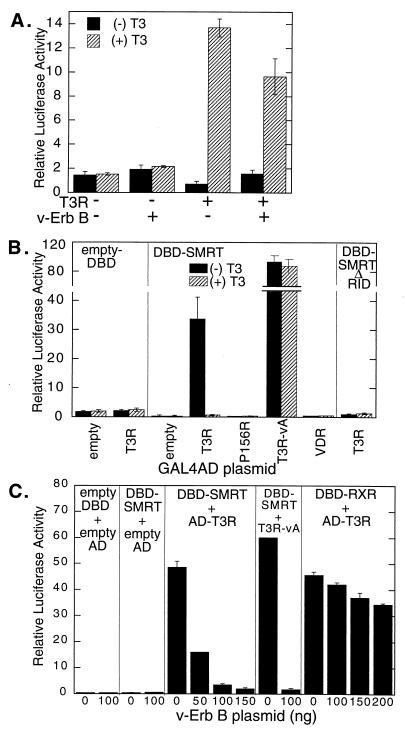FIG. 1.
Effect of EGF receptor–v-ErbB signaling on T3R transcriptional repression and interactions with SMRT. (A) Inhibition of T3R-mediated repression by v-ErbB. CV-1 cells were transfected with empty plasmid pSG5 or plasmid pSG5-T3Rα in the presence or absence of a v-ErbB expression plasmid, as indicated below the panel. Cells were then incubated in the presence (+) or absence (−) of 1 μM T3, and the expression of a T3R-responsive (TRE) luciferase reporter was determined relative to that of a constitutive pCMV-lacZ reporter used as an internal control. (B) Interaction of T3Rα with SMRT in a mammalian two-hybrid assay. A pSG5-GAL4DBD plasmid containing no insert (empty-DBD), containing the RID (amino acids 751 to 1495) of SMRT (DBD-SMRT), or containing SMRT bearing a deletion of the RID (DBD-SMRTΔRID) was cotransfected into CV-1 cells together with a GAL4–17-mer luciferase reporter and a pSG5-GAL4AD construct. The pSG5-GAL4AD construct, indicated below the panel, contained no insert (empty), the wild-type T3Rα ligand binding domain (T3R), the T3Rα ligand binding domain with a P156R mutation that disrupts SMRT association (P156), the analogous region of the v-ErbA mutant form of T3Rα (T3R-vA), or the vitamin D3 receptor (VDR). The cells were incubated in the absence or presence of 1 μM cognate hormone, and luciferase activity was determined relative to the β-galactosidase activity of the pCH110 plasmid introduced as an internal control. (C) v-ErbB inhibition of the two-hybrid interaction between T3Rα and SMRT. The same mammalian two-hybrid vectors as those described for panel B and GAL4DBD fused with the ligand binding domain of RXRα were cotransfected into CV-1 cells in various combinations, as indicated for each panel. In addition, the cells were cotransfected with the indicated amounts of the v-ErbB expression plasmid (0 to 200 ng), the GAL4–17-mer luciferase reporter, and a pCMV-lacZ internal control plasmid. The cells were incubated in the absence of T3, and the relative luciferase activity was determined. The average and standard deviation of duplicate experiments are presented.

